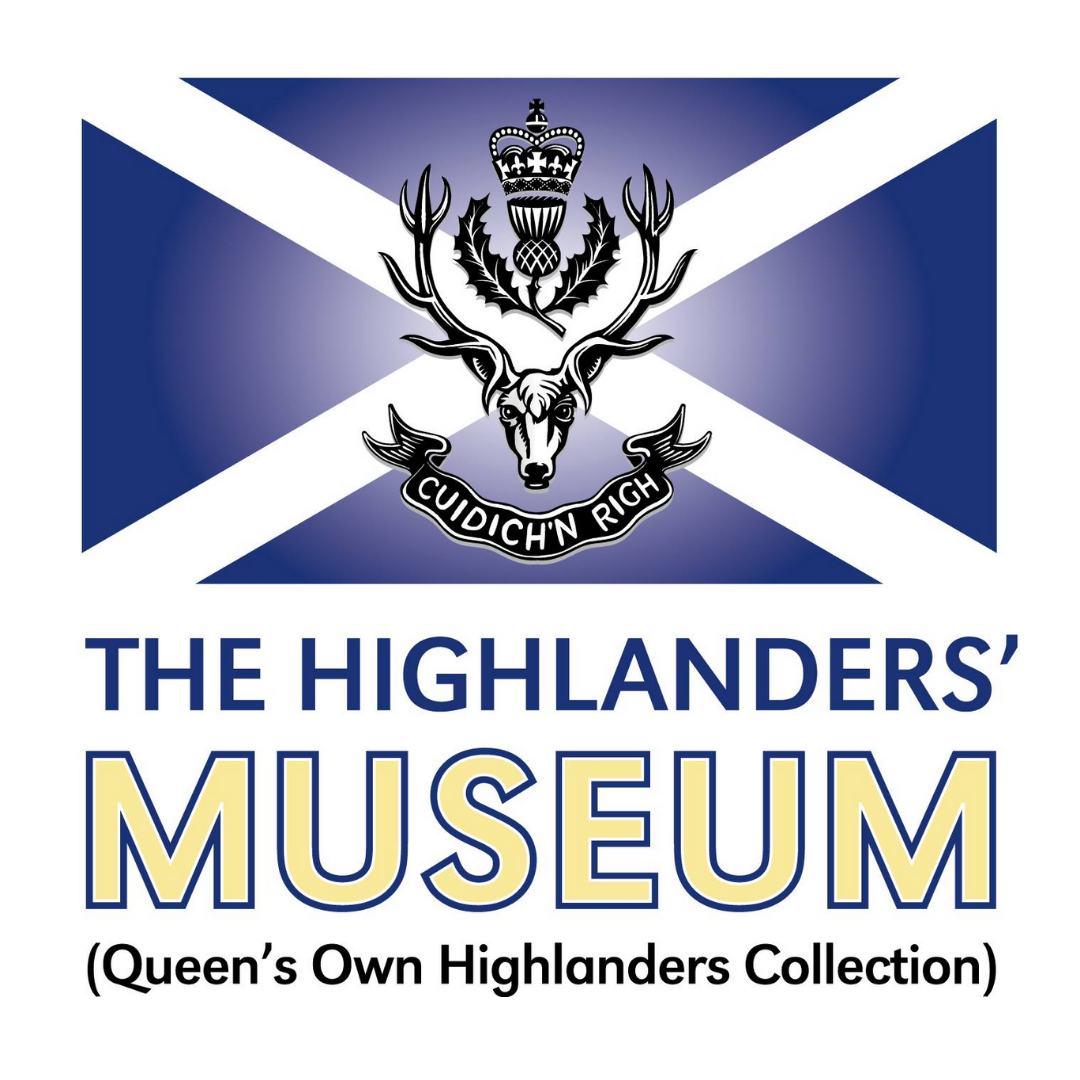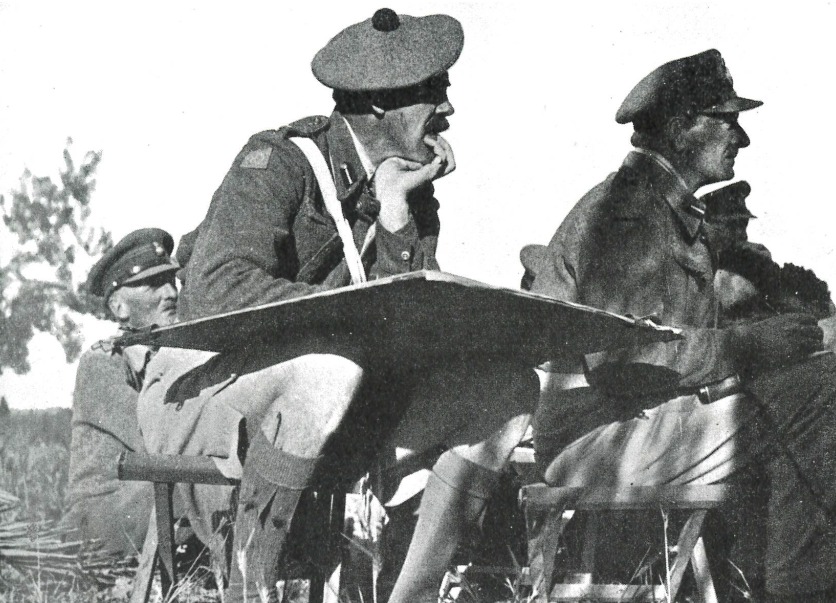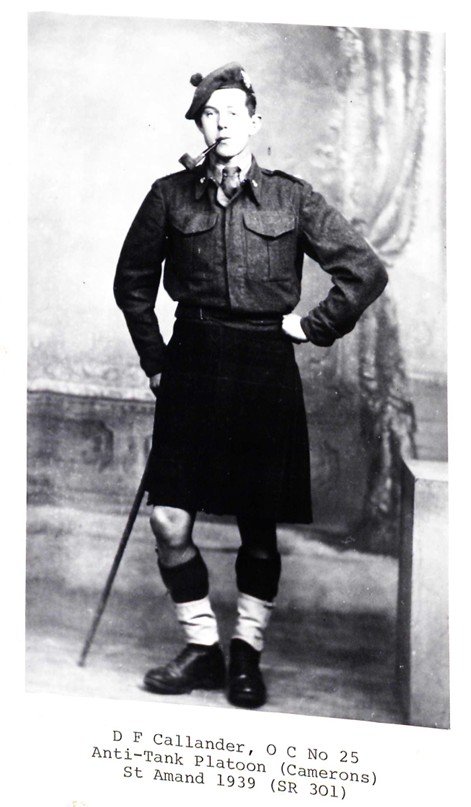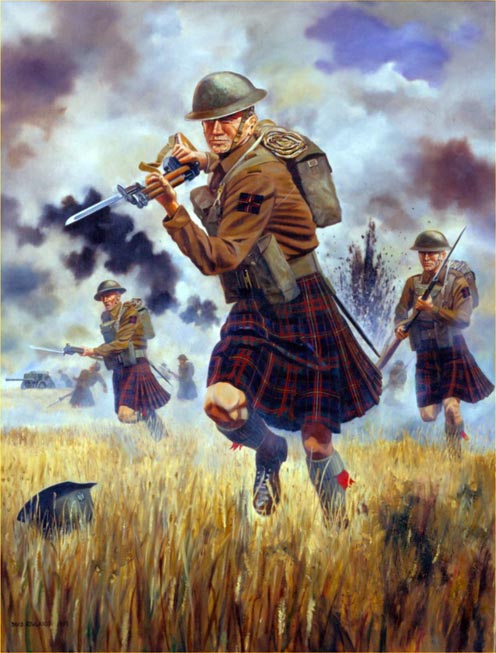The Last Highland Fling
One of the best things about volunteering at the Highlanders Museum are the photos, letters, diaries and documents sent to us by relatives of those who served in WWI, WWII and more often these days in post-war conflict. So we are very grateful to have received a stack of information from Robin Callender, son of Major Donald Callender, MC and bar, who served with the 1st Battalion Queen’s Own Cameron Highlanders in WWII.
What made this particular batch of documents interesting was a transcript of Major Callander’s interview with the Imperial War Museum, recorded in 1983, of his experiences with the British Expeditionary Force in northern France in May 1940, and in particular the rearguard action at La Bassee on 27th May 1940 where the 1st Battalion QOCH briefly held back Rommel’s 7th Panzer Division. Not only was this one of the last offensive actions before the chaotic evacuation from Dunkirk, it was also the last time a Highland Battalion fought as a complete unit wearing the kilt.
So how did the Battalion find themselves in this position, and why were they wearing their kilts months after other Highland regiments had folded theirs away? The 1st QOCH were a regular army battalion based at Aldershot when war was declared on 3rd September 1939. Assigned to 5th Brigade, 2nd Infantry Division, they mobilised to France on 23rd September dressed in ‘Field Service Marching Order’ consisting of the service dress jacket, kilt, khaki hose and puttees. Not long after arriving in France the War Office issued a General Order that “the active service dress of the Highland Regiments would be the universal battledress”. The order was met with sadness by some, and fury by others – none more so than their Commanding Officer at the time, Lieutenant-Colonel D.N.Wimberley, and when the new battledress trousers arrived in February 1940 he ordered that every Cameron in the 1st Battalion, except drivers, continue to wear their kilts on all occasions.
On 25th May the Battalion was ordered up to La Bassee to relieve the 7th Queens. Battalion HQ was established in a farm house at Violaines, a small village bordering La Bassee. To the west, on the Cameron’s right, was a TA Battalion, the 7th Worcesters, and during the 26th May the Germans started to cross the canal opposite them. By morning on the 27th, the Germans were over in some strength, and despite a brave counter attack by six French tanks and a Company of Camerons, were threatening La Bassee itself.
By late morning enemy tanks were reported massing on the Battalion right flank about 800 yards away. Their markings could not be seen so the CO, Lt Colonel Patrick Miller, asked Brigade HQ whether they were British, French or German and received the reply that they were probably not British, and they advised firing on them to discover their nationality (so no problem firing on them if
they were French then!). As there was no artillery fire available the CO sent out Captain Stewart on a motorcycle to determine whose tanks they were and he returned 20 minutes later to report that he had been fired on “thus establishing their identity beyond doubt”.
The CO requested Brigade HQ for either artillery or air support to disperse the tank concentration and after none was forthcoming at 13:00 he requested the Anti-Tank Platoon to be sent up as soon as possible.
13:40 The A/T Platoon, under 2nd Lt D.F.Callander arrived at Bn HQ and at 14:05 was in position.
DFC: Having sited each gun and told them to get on with it, I established Platoon HQ near the centre of Violaines near the Church. I quickly realised, however, that the steeple seemed to be the main target of the German artillery and so I moved nearer Bn HQ’s farm house where at this time things were quieter. On going round my gun positions I found the Worcester platoon, who were in theory providing local protection for my left-hand gun, were all at the bottom of their slit trenches. Not a head was keeping watch and they were down [now?] under this comparatively light shell fire – it was a forerunner of the support we got when the attack broke out properly.
The three guns of the platoon were put on the defensive flank of the Battalion and at 14:10 opened fire.
DFC: The tanks were moving parallel to the canal. And I was between them and the canal. So they were facing not me but heading for La Bassee. So when we opened up, I do not think they knew where the hell we were shooting from. And I could only be with one gun and I was with this gun. And we fired – I think it must be a record – we fired eighty rounds of anti-tank ammunition.
14:25 The (enemy) attack started.
The enemy divided his tanks in to three groups, one group attacked Bn HQ at Violaines, and the other two attacked La Bassee from the East and West. The first group of tanks that attacked Bn HQ moved north of Violaines-Givenchy ridge, as did the third group that attacked the East side of La Bassee. These two groups could easily be watched from our OP established on the roof of Brigade HQ, where for a time the Liaison Officer, 2/Lt Fraser, was. The two groups moved over the ridge and then turned East. Some attacked Violaines, others passed to the north of it to attack La Bassee from the East. Those south of the ridge attacking La Bassee from the East could not be seen from Brigade.
It is estimated that about 100 tanks took part in each group, and they were proceeded by light tanks which were followed by medium tanks. These medium tanks were armed with a gun firing an incendiary shell. There was about one medium tank to fifteen lights, and the
light tanks used their machine guns, whilst the medium tanks set fire to anything inflammable.
14:30 Battalion HQ was hit by incendiary shells and three of the Intelligence Section were killed or wounded. The straw in the farmyard blazed up, and eventually the whole farm caught fire.
14:40 The German tank advance continued slowly but steadily. They were in some degree held up by the accurate fire of 2 Lt Callander’s Pl. of A/T guns.
DFC: I was just going to get some more ammunition. And as I came back with it the Germans had finally woken up that the fire was coming from their left flank and they swung. Well, this gun could knock out tanks in the flank but could not knock them out head on. And also they began to see the flashes of where (the shells) were coming from. So they landed a shell slap on the guard of the one I was just coming up to replenish with ammunition. And the layer was badly hit and so was the rest of the gun crew.
The gunner layer, Private Pinkerton, came up to me and said “Sir” – he was bleeding from the chest, bleeding from the mouth but he was still standing – “Sir, I wish to report that whilst on active service I have lost my dentures”. Now, the point was in the regular army if you lost anything you had to pay for it unless you reported it to an officer or senior NCO on the spot. And he’d lost his dentures and he knew bloody well that if he didn’t report it he would have to pay for them. But it shows you, in the middle of a battle that his mind was so conditioned to discipline – not war but discipline – that is what he said.
14:45 The CO made another enquiry after the long promised counter-attack by our own tanks. Brigade could give no reassuring information, and the Battalion was told to hold on.
15:15 By this time the tanks were within 80 yards of Battalion HQ and firing steadily and accurately at it. La Bassee itself could hardly be seen on account of the smoke from fires burning there and no information was forthcoming from the forward Companys. The signal line had been broken frequently, despite the greatest efforts of Sgt B.Morgan and his party of linesmen to keep it in working order.
DFC: By that time the fire was absolutely intense because if you’ve ever come across machine guns from tanks it’s just like a hosepipe firing water. But luckily there were houses there and between the houses this spray of bullets was going through. And so I dodged back, and reported to the CO who was in the cellar directing the battle. So I went down and said, “Sir, I think you ought to withdraw because there’s a German tank in the garden. And I can’t withdraw because I’m afraid I’ve lost that gun, I’m out of touch with my left-hand gun and my right-hand gun and the German tanks have now come all around us”. So he said, “Yes”. And he got out actually. He owes the fact that he wasn’t a prisoner of war to me because if I hadn’t gone down to the cellar he wouldn’t have realised where the German tanks were.
15:20 The CO got through to Brigade HQ on the wireless and reported the situation. By this time the German infantry had arrived in trucks behind tanks and leapt out of them to take the position. Actually, from the Brigade OP there could be seen at this time about a Battalion of infantry advancing by sections in file, well deployed and in perfect order as if they were on parade.
15:25 The Brigadier, on receiving this information, ordered the withdrawal of the Battalion.
15:20 The A/T Platoon under 2/Lt Callander, had by thus time knocked out twenty-one enemy tanks by its accurate fire, but naturally was forced to join in the withdrawal with the Bn. 2/Lt Callanders conduct on this occasion was most praiseworthy, and he was recommended for an immediate award of the Military Cross, which later was granted, the citation reading:
2/Lieut Callander commanded a pl. of 25mm anti-tank guns on May 27 at 1300 hrs this pl was attached to 1 Camerons and placed on the defensive flank on the right at LA BASSEE. At 1425 hrs the enemy attacked with tanks. This pl put 21 enemy tanks out of action. 2/Lieut Callander shewed a splendid example to his men and when the order for withdrawal was given managed to collect most of his men spread along the front and led them back to safety. His energy and leadership was a factor which proved itself in the wonderful behaviour of his men.
The Camerons lost 19 men killed at La Bassee, and many more wounded, missing or captured. Only 79 men from an initial Battalion strength of 650 who embarked for France eventually made it back to the Regiment when they regrouped in Yorkshire in the months following Dunkirk.

Later Major Callander observed the following about the kilt, and its effect on the men:
“If the morale effect of wearing the kilt was as great on the enemy as it was on our own troops, the advantages were indeed great. During our transfer from Regiment to Regiment as my platoon was allocated to thicken up the meagre anti-tank resources of other divisions, the confidence placed in the Jocks was overwhelming. It is no exaggeration to say that the mere arrival of twenty kilted Camerons with their three small guns often had the effect of restoring the confidence of already rather badly shaken infantry”.
Sadly this was not enough to save the kilt, and the universal battle dress became the standard on active service from then on. However, the Camerons, by order of their Colonel-in-Chief, HM King George VI, were granted the honour of wearing a blue hackle in their bonnets. A tradition maintained by the officers and men of 4 SCOTS (the Highlanders), the Royal Regiment of Scotland, to this day.



